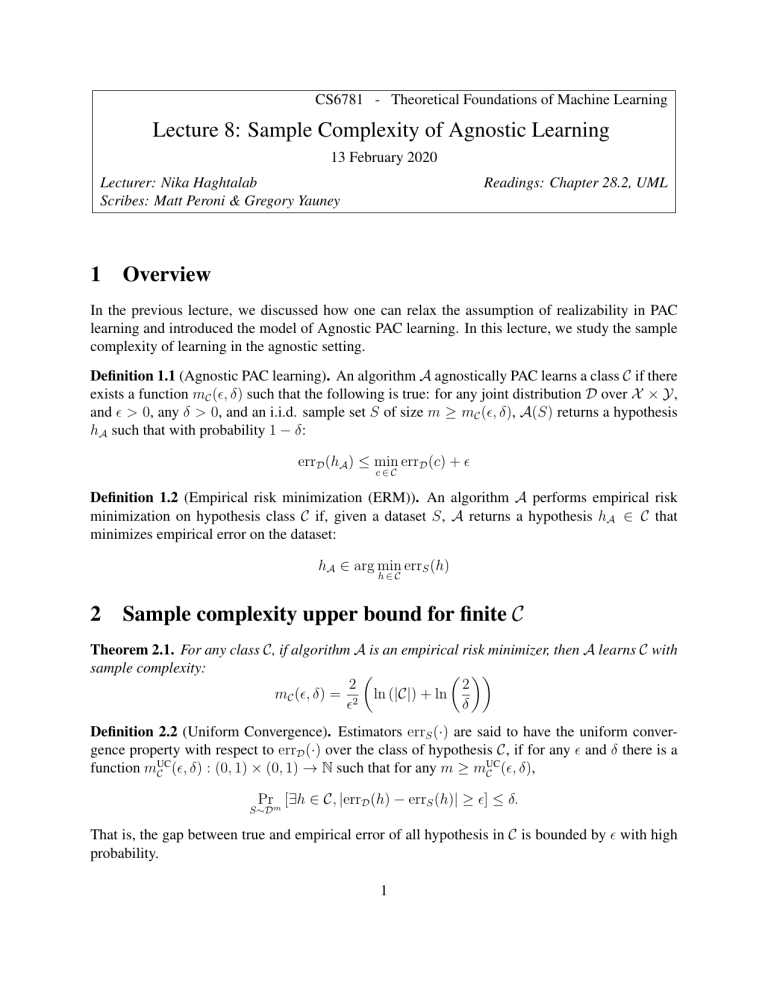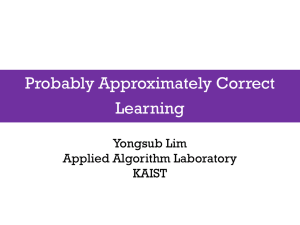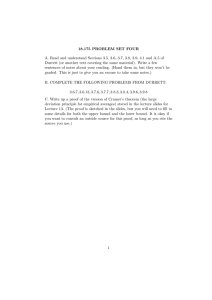
CS6781 - Theoretical Foundations of Machine Learning
Lecture 8: Sample Complexity of Agnostic Learning
13 February 2020
Lecturer: Nika Haghtalab
Scribes: Matt Peroni & Gregory Yauney
1
Readings: Chapter 28.2, UML
Overview
In the previous lecture, we discussed how one can relax the assumption of realizability in PAC
learning and introduced the model of Agnostic PAC learning. In this lecture, we study the sample
complexity of learning in the agnostic setting.
Definition 1.1 (Agnostic PAC learning). An algorithm A agnostically PAC learns a class C if there
exists a function mC (, δ) such that the following is true: for any joint distribution D over X × Y,
and > 0, any δ > 0, and an i.i.d. sample set S of size m ≥ mC (, δ), A(S) returns a hypothesis
hA such that with probability 1 − δ:
errD (hA ) ≤ min errD (c) + c∈C
Definition 1.2 (Empirical risk minimization (ERM)). An algorithm A performs empirical risk
minimization on hypothesis class C if, given a dataset S, A returns a hypothesis hA ∈ C that
minimizes empirical error on the dataset:
hA ∈ arg min errS (h)
h∈C
2
Sample complexity upper bound for finite C
Theorem 2.1. For any class C, if algorithm A is an empirical risk minimizer, then A learns C with
sample complexity:
2
2
mC (, δ) = 2 ln (|C|) + ln
δ
Definition 2.2 (Uniform Convergence). Estimators errS (·) are said to have the uniform convergence property with respect to errD (·) over the class of hypothesis C, if for any and δ there is a
UC
function mUC
C (, δ) : (0, 1) × (0, 1) → N such that for any m ≥ mC (, δ),
Pr [∃h ∈ C, |errD (h) − errS (h)| ≥ ] ≤ δ.
S∼Dm
That is, the gap between true and empirical error of all hypothesis in C is bounded by with high
probability.
1
We show that uniform convergence is sufficient for agnostic learning.
Proof of Theorem 2.1. The proof is almost exactly as in the realizable PAC setting. We care about
the probability that errD (h) is large but errS (h) is small. Fix a hypothesis h ∈ C. If we can bound
the probability of too large a gap between true and empirical errors for this fixed hypothesis, then
we can use the union bound to bound the probability that any hypothesis in C has too large a gap.
That is, if we can show for a fixed h:
h
−m2
i
≤ 2 exp
(1)
Pr |errD (h) − errS (h)| ≥
2
2
Then we can apply the union bound across all hypotheses in C to show:
h
i
−m2
Pr ∃h ∈ C s.t. |errD (h) − errS (h)| ≥
≤ 2 |C| exp
2
2
This is the same as saying C has uniform convergence property with parameters
what we are really showing is the following claim.
2
and δ. So
Claim 2.3. Uniform convergence with parameters 2 , δ =⇒ ERM agnostically PAC learns C with
parameters , δ.
bad hypotheses
errD
errS
h?
h
h0
0
1
h? h0
0
2
1
2
bad hypotheses
Let h? ∈ arg minh∈C errD (h) be an optimal classifier and let h be a hypothesis with mimimum
errS (h) returned by ERM. Now let h0 be any classifier such that errD (h0 ) > errD (h? ) + . Then,
by uniform convergence errS (h0 ) > errD (h0 ) − 2 . Moreover, errS (h? ) < errD (h? ) + 2 . Therefore,
errS (h0 ) > errS (h? ), so h0 cannot be the returned by the ERM. We can see this visually in the
figure above.
So, all that is left to do is to prove Equation (1) above. We use the Hoeffding bound. In order
to do so, we must define the error in terms of a sum of independent random variables.
(
1 if h misclassifies xi
Define a random variable for each example in S: X1 , . . . Xm , where Xi =
0 otherwise
2
We can relate these independent random variables to the errors:
m
X=
1 X
1
· # of samples h misclassifies = errS (h)
Xi =
m i=1
m
E [X] = errD (h)
Now apply the Hoeffding bound: Pr [|errD (h) − errS (h)| ≥ ] ≤ 2 exp (−2m2 )
Plugging in 2 :
h
−2m2
−m2
i
≤ 2 exp
= 2 exp
Pr |errD (h) − errS (h)| ≥
2
4
2
Bounding this probability by δ gives us the value of m in the claim.
3
Sample complexity upper bound for infinite C
The following theorem upper bounds the sample complexity of agnostic learning for infinite hypothesis classes in terms of the VC dimension.
Theorem 3.1. ERM agnostically PAC earns C with sample complexity:
1
1
mC (, δ) ∈ O 2 VCDim (C) + ln
δ
The proof of this theorem relies on a technique called “chaining”, which we will not cover in
this class. Instead we will show the following weaker bound in this lecture:
1
1
mC (, δ) ∈ O 2 ln (ΠC (2m)) + ln
δ
By Sauer’s lemma, this gives us:
1
1
1
mC (, δ) ∈ O 2 VCDim (C) ln
+ ln
δ
Remark 3.2. This sample complexity in the agnostic setting has an additional factor of 1 compared
to the realizable setting.
Proof sketch. The proof is very similar to the sample complexity upper bound for realizable PAC.
Therefore, we only highlight some of the major steps.
Take S ∼ Dm , and for the sake of analysis imagine an independent sample set S 0 ∼ Dm .
Define the following “bad” events:
B(S) : ∃h ∈ C such that |errS (h) − errD (h)| >
3
2
4
00
0
B (S, S , ~σ ) : ∃h ∈ C such that |errT (h) − errT 0 (h)| >
4
B 0 (S, S 0 ) : ∃h ∈ C such that |errS (h) − errS 0 (h)| >
In the final event, T and T 0 are defined by ~σ ∈ {−1, +1}m , which swaps elements of S and S 0 :
(
(
add xi to T 0
add xi to T
If
σ
=
−1
→
If σi = +1 →
i
add x0i to T
add x0i to T 0
Just as in the proof of Theorem 1.1 of Lecture 5, it is sufficient to show that PrS∼Dm [B(S)] ≤ δ.
Claim 3.3. For large enough m ∈ O(1/2 ),
Prm [B 0 (S, S 0 )|B(S)] ≥
S∼D
1
2
Proof. Take a hypothesis h such that |errS (h) − errD (h)| > 2 . Then, by Jensen’s inequality we
have
ES 0 ∼Dm [|errS 0 (h) − errS (h)|] ≥ |ES 0 ∼Dm [errS 0 (h)] − errS (h)|
≥ |errD (h) − errS (h)|
≥
2
We want to show:
h
i 1
0
0
Pr
≤
|err
(h)
−
err
(h)|
−
E
[|err
(h)
−
err
(h)|]
>
S
S
S
S
S 0 ∼Dm
4
2
Note that |err
S (h) − errS 0 (h)|
can be represented by the random variables:
0
0
1 h(xi ) 6= yi 6= 1 h(xi ) 6= yi , so we can use the Hoeffding bound for m >
1
2
samples.
This claim implies that Pr [B(S)] ≤ 2 Pr [B 0 (S, S 0 )], so it suffices to bound Pr [B 0 (S, S 0 )].
Claim 3.4. For i.i.d. sample sets S ∼ Dm and S 0 ∼ Dm and a vector ~σ , where σi = +1 or −1
with probability 1/2 for all i ∈ [m] independently, we have
Pr [B 0 (S, S 0 )] = Pr0 [B 00 (S, S 0 , ~σ )]
S,S 0
S,S ,~
σ
Proof. T, T 0 and S, S 0 are identically distributed.
It now suffices to bound Pr [B 00 (S, S 0 , ~σ )] in order to prove the theorem.
Claim 3.5. For a fixed S, S 0 ∈ X m and any h that is fixed (independently of ~σ ), we have
2 h
i
− m
0
Pr |errT (h) − errT 0 (h)| ≥ | S, S ≤ 2 exp
~
σ
4
8
4
Proof. We can rewrite our expression using indicator variables as
1 X
σi (1(h(xi ) 6= yi ) − 1(h(x0i ) 6= yi0 ))
errT (h) − errT 0 (h) =
m i
P
Let us denote the term in the summation by zi and let z = m1 i zi . Recognizing that zi is a
random variable in [−1, 1] with expected value 0, we can apply the Hoeffding bound to obtain the
statement in the claim. That is,
2 h
− m
i
≤ 2 exp
Pr |z − E[z]| ≥
4
8
as desired.
With Claim 3.5, we can formulate the last step in our proof.
Claim 3.6.
i
h
−2 m
)
Pr ∃h ∈ C : |errT (h) − errT 0 (h)| ≥ |S, S 0 ≤ 2ΠC (2m) exp(
4
8
Proof. By the union bound, we have that
ΠX
C (2m)
0
0
Pr ∃h ∈ C : |errT (h) − errT 0 (h)| ≥ S, S ≤
Pr |errT (hi ) − errT 0 (hi )| ≥ S, S
4
4
i=1
2 − m
= 2ΠC (2m) exp
8
Where we sum over ΠC (2m) hypotheses because that is the maximum possible number of unique
hypotheses for 2m samples S ∪ S 0 in C. The last line of the argument is from Claim 3.5.
Bounding the probability in Claim 3.6 by δ/2, we arrive at
8
4
mC (, δ) = 2 ln (ΠC (2m)) + ln
δ
4
Agnostic PAC sample complexity lower bound
Theorem 4.1. Any algorithm that agnostically PAC learns a hypothesis class C with VC-dimension
d and parameters , δ has sample complexity:
1
1
m ∈ Ω 2 d + ln
δ
We will prove the claim that when δ = 17 , m ≥
5
d
3202
samples are required.
4.1
High-level idea
Consider the following experiment. Imagine two coins.
(
(
3
1
H
H
Coin 1: 41
Coin 2: 43
T
T
4
4
Choose one of these coins uniformly at random and flip that coin N times and see how many
of these turns out heads and how many tails. What’s the best strategy for guessing which coin was
chosen? It is not hard to see that the best strategy is to guess coin 1 if more than half of the coin
tosses are heads, and guess coin 2 otherwise. Indeed this strategy is best even for the following
two coins.
(
(
1−
1+
H
H
2
2
Coin 2: 1+
Coin 1: 1−
T
T
2
2
As approaches 0, the chance that our rule guesses the correct coin gets worse. That is because
the probability that coin 1 is chosen but less than half of the coin tosses are heads (and coin 2 is
chosen but more than half of the coin tosses are heads) increases for a fixed N as → 0. How many
coin flips N are sufficient
to guess correctly with fixed probability δ? Hoeffding bound dictates
that N = O 12 ln 1δ is sufficient: For coin 1,
1+
# heads
−N 2
Pr
− >
≤ exp
≤ δ.
2
2
N
4
As it turns out, Hoeffding bound is tight when the expected value E [X] is close to 12 . This is
shown by the following inequality:
s
!
1+
# heads
1
−N 2
Pr
− >
>
1 − 1 − exp
(Slud’s Inequality)
2
2
N
2
1 − 2
2
So if N < 1−
then there is a constant probability of guessing incorrectly. We will use this to
2
construct an example where the best learner has to see many samples to get a small error.
4.2
Lower bound
Take the set Z = {x1 , . . . , xd } shattered by C. The following class of distributions have the
property that Bayes optimal classifier is almost as bad as any: For any ~b ∈ {−1, 1}d
(
1+ρ
yi = b i
2
D~b : Has marginal distribution that is uniform on X and Pr[yi |xi ] = 1−ρ
yi = −bi
2
The Bayes optimal classifier is h~?b (xi ) = bi because the label of xi is more likely to be bi than −bi .
6
For any h ∈ C and any ~b:
errD~b (h) − errD~b (h~?b ) =
1 2ρ
·
· {i : h(xi ) 6= h~?b (xi )}
d 2
When h(xi ) 6= yi and h~?b (xi ) = yi , when h is incorrect but the Bayes optimal classifier is
correct, there is an ρ difference in error. Samples are independent so seeing others gives no extra
knowledge.
Claim 4.2 (With no proof). Choose a D~b by taking bi ∼ Unif({−1, +1}) independently. The
algorithm A(·) with best error in expectation over ~b and S, returns a classifier h such that h(xi ) =
+1 if more than half of the xi that appear in S are labeled +1 and −1 otherwise.
Proof ideas. This can be proved by repeating the above coin experiments. Since bi ’s are chosen independently (and Z is shattered by C) what the optimal A(S) predicts for xi should be independent
of what it predicts for xj .
We want to show that
ρ
E~b∼Unif ES∼D~m errD~b (h) − errD~b (h~?b ) ≥
b
4
Claim 4.3. For any algorithm A if m ≤
d(1−ρ2 ) ln(4/3)
,
ρ2
ρ
E~b∼Unif ES∼D~m errD~b (hA(S) ) − errD~b (h~?b ) ≥ .
b
4
Proof sketch. Claim 4.2 shows that rather than taking ~b uniformly and considering the expected
behavior of the best algorithm, we can fix ~b and assume that the algorithm is as described in Claim
4.2. Let pS (xi ) be the fraction of xi points that appear in S and are labeled +1.
E~b ES∼D~m errD~b (hA(S) ) − errD~b (h~?b )
b
h
1
1 i
ρ
≥ · Prm {i | bi = +1 ∧ pS (xi ) < } ∪ {i | bi = −1 ∧ pS (xi ) ≥ }
d S∼D~b
2
2
s
!
ρ
− (m/d) ρ2
≥
1 − 1 − exp
,
2
1 − ρ2
Where last inequality states (without proof) that best case scenario for the algorithm is if each
instance xi gets an equal md of the samples and then uses the probability of the bad event in Section
2
4.1, the coin experiment. This is ≥ ρ4 if m ≤ d(1−ρ ρ)2ln(4/3) .
Claim 4.4. For any ρ ≤
1
2
and for every algorithm A, there is a distribution D such that if m ≤
ρ
1
Prm errD (hA(S) ) − min errD (h) >
>
S∼D
h∈C
8
7
7
d
,
5ρ2
Proof. The proof is the same as in realizable PAC. It is immediate to go from expectation over all
2
D~b to existence of a bad distribution. Note that m ≤ 5ρd2 ≤ d(1−ρ ρ)2ln(4/3) . Let ∆ = errD (hA(S) ) −
minh∈C errD (h). Because ∆ ∈ [0, ρ] and E [∆] ≥ ρ4 , we have Pr ∆ > ρ8 = p > 17 :
ρ
ρ
≤ pρ + (1 − p)
4
8
1
=⇒ p ≥
7
Setting ρ = 8 gives us the proof of Theorem 4.1.
8




